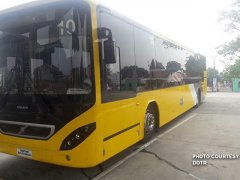News
Over 5K MRT passengers take P2P buses Tuesday

The electrical failure was caused by worn-out electrical sub-components such as regulator, insulators and chopper. (PNA photo)
MANILA — More than 5,000 passengers took the point to point (P2P) buses Tuesday morning which were deployed by the Department of Transportation (DOTr) as an alternative mode of transportation to the Metro Rail Transit Line 3 (MRT-3).
A total of 79 buses served 5,807 passengers making 110 trips, according to Inter-Agency Council on Traffic (I-ACT) spokesperson and Land Transportation Franchising and Regulatory Board (LTFRB) member Aileen Lizada.
Data from the DOTr showed that as Monday, 557 buses made 745 trips serving 40,867 passengers since the MRT-3 bus augmentation project started last February 1, 2018.
The department has earlier said that P2P bus operators have committed to complete two trips in the morning rush hour and one trip in the afternoon rush hour.
For the morning rush hour, buses will still pick up MRT passengers at the North Avenue and Quezon Avenue stations but they will now be making a second trip so that more passengers may avail of the service.
During the afternoon rush hour, buses will pick up passengers either at Taft Avenue or Ayala Avenue with drop-off points at Shaw, Cubao and North Avenue stations.
Meanwhile, the MRT-3 management said that around 1,070 passengers were unloaded after an electrical failure on the braking system occurred in a southbound train between Ortigas and Shaw Boulevard at 6:32 a.
m. Tuesday.
The electrical failure was caused by worn-out electrical sub-components such as regulator, insulators and chopper.
“At 7:09 a.m., the defective train was moved back to the depot for diagnosis and repair,” MRT-3 media relations officer Aly Narvaez said in a text message to reporters.
“We are on normal operations since we started operations today,” she added.
The average ridership of the railway system has reduced to around 260,000 passengers for the first two weeks of February as eight to nine trains operate daily based on data from the MRT-3.
In 2017, the MRT-3 has an average daily ridership of 463,000 from 20 operating trains which was later reduced to 15 in order to ensure passenger safety.
From 15 working trains by the end of 2017, the MRT has lowered its target to just 10 to 12 trains in order to accommodate passengers.
The DOTr expects improvement in the MRT operations once the general overhaul of trains is concluded after the Holy Week break and with the increase in the number of running trains due to the arrival of spare parts. (PNA)





















